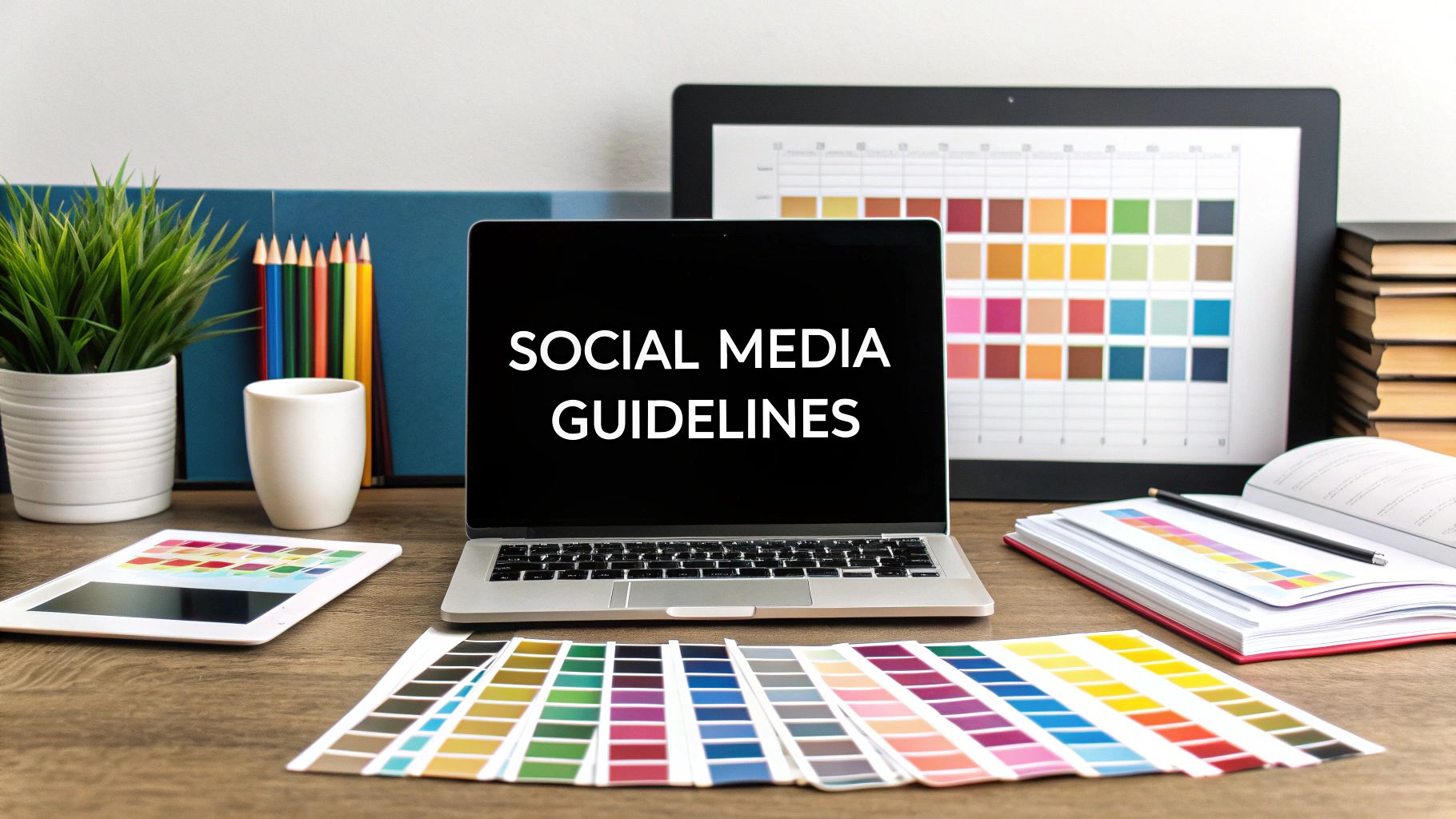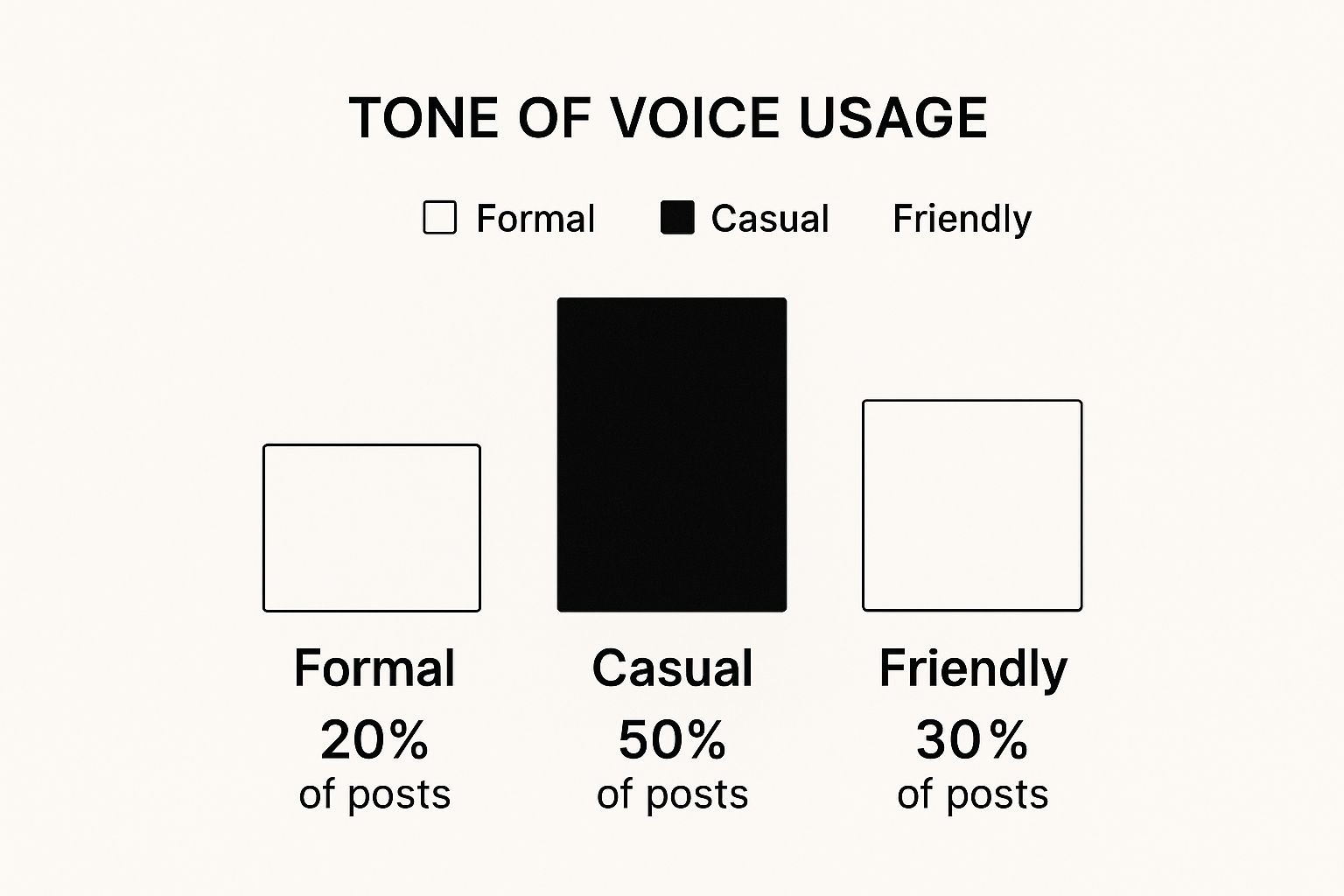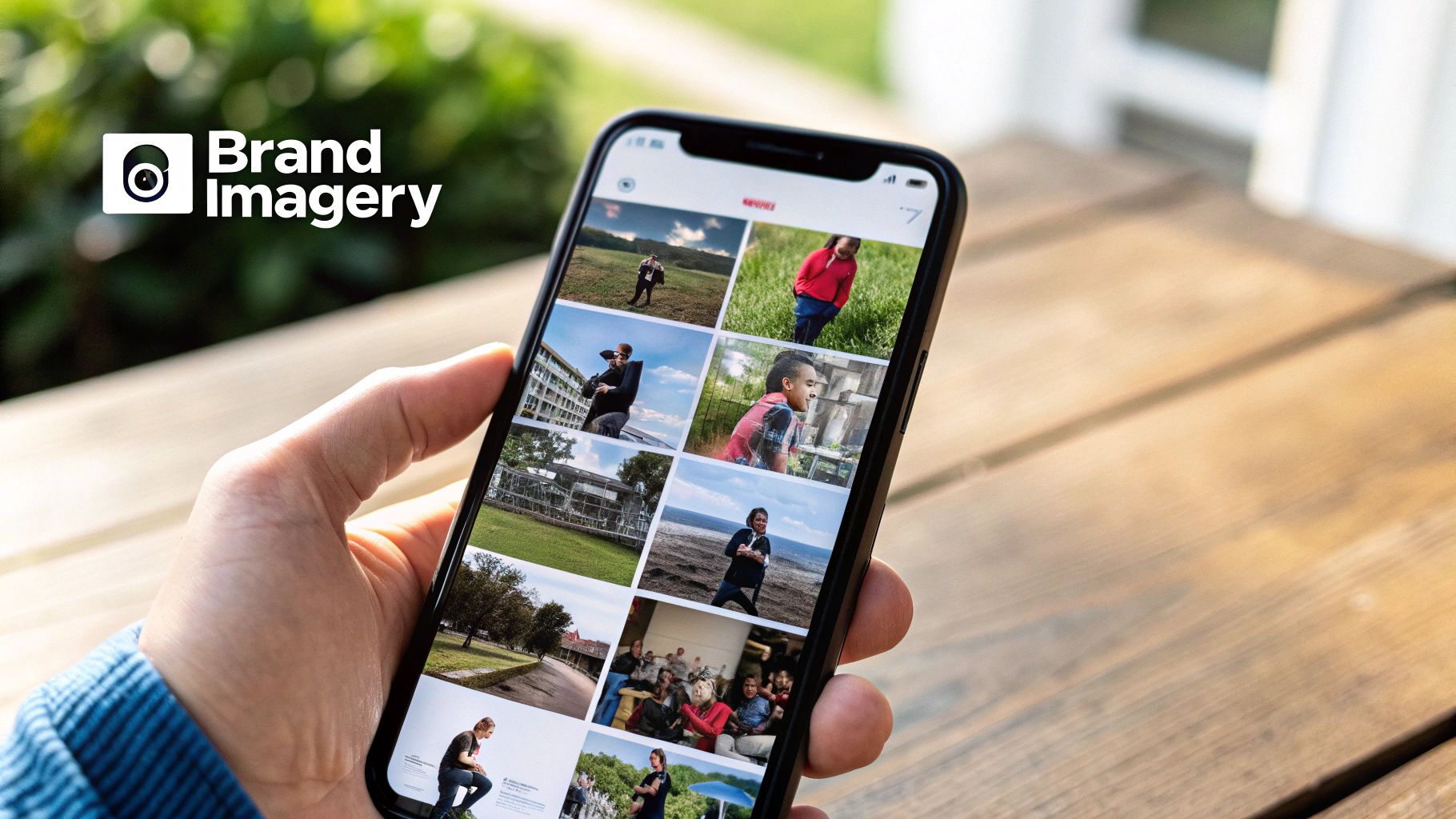
Create Strong Social Media Brand Guidelines
Build your social media brand guidelines with this expert guide. Learn to create a consistent brand voice, visual identity, and engagement strategy that works.
Think of your social media brand guidelines as the master playbook for your brand's personality online. It’s the single source of truth that ensures every post, tweet, and story feels consistent, recognizable, and intentional. Consider it your brand's digital passport—the official document that proves who you are, no matter which social platform you’re on.
Why Your Brand Needs Social Media Guidelines
In an endless sea of digital content, inconsistency is the fastest way to get lost in the noise. When a brand feels chaotic or disjointed across different channels, it completely undermines the trust you need to build a loyal audience. This is exactly why having clear social media brand guidelines has gone from a "nice-to-have" to a non-negotiable for any business serious about making an impact.
Imagine your brand is a person. Without guidelines, it's like a group of actors all trying to play the same character but with completely different scripts. On Monday, your brand is buttoned-up and corporate on LinkedIn. By Tuesday, it's dropping trendy slang and memes on Instagram. This kind of whiplash just confuses people and dilutes your identity. A solid guide makes sure everyone—from marketers to customer service reps—is on the same page, speaking with one clear, unified voice.
The Foundation of Audience Connection
Great guidelines aren't just about enforcing rules; they're about forging real connections. When your audience consistently sees the same visual style, voice, and values, they start to recognize you. Then, they begin to trust you. That predictability feels professional and reassuring, making them far more likely to engage, follow, and eventually buy from you. The goal isn't just to be seen—it's to be remembered long after they've scrolled away. You can learn more about building this kind of unforgettable presence in our complete social media branding guide.
A strong brand presence isn’t just about being seen; it’s about being remembered for the right reasons. Your guidelines are the foundation that ensures every post, comment, and campaign contributes to a memorable and trustworthy identity.
To build a guide that truly works, you need to cover all the essential bases. It's not just about logos and colors; it's about the entire communication ecosystem.
Here’s a quick breakdown of what a complete and effective set of guidelines should include.
The Pillars of Effective Brand Guidelines
| Pillar | What It Defines | Why It Matters | | :--- | :--- | :--- | | Visual Identity | Logos, color palettes, fonts, and image styles. | Creates instant brand recognition and visual consistency. | | Brand Voice & Tone | The personality, language, and attitude of your brand. | Builds an emotional connection and makes the brand relatable. | | Posting Rules | Hashtag usage, post frequency, and content formats. | Ensures a cohesive and strategic content delivery. | | Engagement Protocol | How to respond to comments, messages, and mentions. | Protects brand reputation and fosters community. | | Crisis Management | Steps for handling negative feedback or PR issues. | Provides a clear action plan to mitigate damage quickly. |
These pillars work together to create a comprehensive framework that leaves no room for guesswork, empowering your team to act confidently and consistently.
Protecting Your Brand in a Fast-Paced World
With the number of active social media users expected to climb to 5.42 billion by 2025, the stakes are higher than ever. That massive audience is a huge opportunity, but it’s also a huge risk. A single off-brand post, a clumsy comment, or an inconsistent message can tarnish your reputation in an instant. If you want to grasp the sheer scale, you can explore more data on social media growth and see for yourself.
Your guidelines are your first line of defense. They provide clear, actionable instructions on everything from crisis communication to which emojis are on-brand. Ultimately, these rules empower your team to be creative within a safe and effective framework, turning your social media presence from a potential liability into a powerful engine for growth.
Crafting Your Visual Identity for Social Media
Your visual identity is your brand's uniform in the digital world. It's the very first thing people see, and on a fast-scrolling feed, that first impression is everything. A strong visual look doesn't just catch the eye; it creates instant recognition and stops the scroll. It's what separates you from being just another post and turns you into a brand people actually remember.
Think of it like a signature recipe. When you use the same key ingredients every single time, you get a consistent, predictable result that people come to love. Your social media guidelines are that recipe—they define your logos, colors, and fonts so every post feels distinctly you.

Defining Your Logo Usage
Your logo is the face of your brand. But without clear rules, it can get stretched, squashed, or slapped on a clashing background, which completely dilutes its power. Your guidelines need to get specific about how it should and shouldn't be used.
Start by defining your primary logo and any other approved versions, like a simplified monogram for profile pictures or a horizontal lockup for banners. Next, you need to establish clear space rules. This is just a fancy term for the breathing room your logo needs. It prevents other design elements from crowding it and ensures it always pops.
Finally, show exactly what not to do. Provide clear examples of your logo on approved backgrounds, and then explicitly forbid things like changing its color, adding cheesy drop shadows, or rotating it. This removes all the guesswork for your team.
Choosing a Digital-First Color Palette
Color is pure emotion and a massive shortcut to brand recognition. In fact, a consistent color palette can boost brand recognition by up to 80%. But what looks great on a printed brochure might look terrible on a screen. Your guidelines need a color palette built for the digital world.
Here’s what to include:
- Primary Colors: These are your go-to brand colors, the ones you'll use most often. Make sure to include the exact HEX and RGB codes for perfect digital consistency.
- Secondary Colors: Think of these as your accent colors. They’re perfect for call-to-action buttons or highlighting key info, adding a bit of visual flair without overpowering your main look.
- Usage Ratios: Give your team a simple formula to follow, like a 60/30/10 rule (60% primary, 30% secondary, 10% accent). This little trick ensures your designs feel balanced and professional every time.
Your color palette is more than just a set of pretty hues; it's the emotional language of your brand. When used consistently, it becomes a silent signal that tells your audience they've arrived at a familiar place.
For more ideas on building out a killer visual identity, this modern social media branding guide is a great resource to dive into.
Selecting Your Brand Typography
Typography is your brand’s voice, but in written form. The fonts you choose say a lot about your personality. Are you clean and modern? Or are you more traditional and elegant? Your brand guidelines need to lay out a clear typographic hierarchy.
- Headline Font: This is for your main titles. It needs to be bold and grab attention, but it absolutely must be easy to read on a small phone screen.
- Subheading Font: This is a secondary font that helps break up text and guide the reader’s eye down the page or post.
- Body Font: This is your workhorse. It’s used for longer text like captions, so readability is the number one priority here.
Don't forget to include specifics on font sizes, weights (like bold or regular), and line spacing. Getting this right makes your content instantly feel more polished, professional, and accessible to everyone.
Finding Your Brand Voice and Tone
If your visuals are your brand's face, your voice is its personality. It’s the difference between being a faceless company and a relatable character your audience actually wants to get to know. This is where your guidelines go beyond logos and colors and dive into the art of conversation.
Think of it like this: your brand voice is the core of your personality. It’s consistent and doesn't change, just like a good friend is always, well, them. Your brand tone, on the other hand, is the emotional inflection you use in different situations. You wouldn't use the same tone to celebrate a win as you would to apologize for a mistake. The same goes for your brand.

The goal here is to trade in that stiff, corporate-speak for a voice that feels real and authentic. To really nail this down, it helps to build out comprehensive brand voice guidelines that your entire team can rally around.
The Brand as a Person Framework
One of the most effective ways to pin down your voice is to imagine your brand as a person. Who are they? Are they a wise mentor, a quirky innovator, or a supportive best friend? Deciding on this archetype will shape every single word you publish.
A great way to start is by picking three to five core personality traits. To make them truly useful, define them with a simple "We are this, but not that" structure.
For example:
- Friendly, but not childish.
- Confident, but not arrogant.
- Expert, but not condescending.
- Witty, but not sarcastic.
This simple exercise instantly creates clear guardrails for anyone creating content. It removes the guesswork and empowers them to write with confidence.
Turning Personality into Practical Rules
Once you know who your brand is, you need to define how it talks. This is where you translate those personality traits into tangible writing rules for your social media guidelines. This is what brings your voice to life on the page.
Here’s what you should define:
- Vocabulary: What words do we love? (e.g., "inspire," "connect," "simplify"). What words do we avoid? (e.g., "synergy," "disrupt," "leverage"). This is your brand's personal dictionary.
- Sentence Structure: Do we use short, punchy sentences or longer, more descriptive ones? An energetic brand might lean toward short and snappy, while a thoughtful one might prefer more flow.
- Formality: Do we use contractions like "you're" and "we'll" to sound more conversational? Or do we stick to "you are" and "we will" for a more buttoned-up feel?
- Punctuation: The little things matter. Are you a fan of the Oxford comma? Do you use exclamation points freely to show excitement, or save them for big announcements?
Your brand voice isn't just about what you say; it's about how you say it. Every word, comma, and emoji should be a deliberate choice that reinforces your brand’s personality and builds a stronger connection with your audience.
Getting this granular ensures that everyone—from a new hire to a veteran marketer—can create content that feels consistently, recognizably you.
A Modern Take on Voice and Tone
While having a consistent voice is your foundation, social media is all about connection and, let's be honest, entertainment. We're seeing a clear trend where teams are loosening the reins a bit, allowing for more tonal flexibility across different channels. It’s a smart move to better engage audiences who crave authenticity over perfectly polished corporate messaging.
This doesn't mean throwing your brand voice out the window. It's about giving your team the freedom to play within the sandbox you've created. Your guidelines should clarify how your tone can and should adapt from one platform to the next.
- LinkedIn: Your tone might be more professional and authoritative, centered on industry insights and data.
- Instagram: It could be more inspirational and casual, leaning into a friendlier, visual-first vibe.
- TikTok: Here, your tone might be playful, funny, and quick to jump on the latest trends.
By setting clear rules for your core voice but allowing for tonal flexibility, you empower your team to create content that’s not just on-brand, but also a perfect fit for its environment.
Setting the Rules for Posting and Engagement
You’ve nailed down your brand's look and voice. Now it's time to build the playbook for how your brand actually behaves on social media. This is where your guidelines get tactical, moving from what your brand is to how it acts in the wild.
Think of it like setting house rules before throwing a party. Clear rules ensure everyone has a good time and nothing gets broken.
Great content doesn't happen by accident; it's the result of a solid strategy. This means you need to define the core themes—or content pillars—that will guide everything you create. These pillars should tie directly back to your business goals. Are you trying to educate, inspire, build a community, or show off your products?
For example, a fitness brand’s content pillars might look like this:
- Workout Tutorials: Showcases products in action and provides immediate value.
- Nutritional Tips: Builds authority and educates the audience.
- Member Spotlights: Creates a sense of community and provides powerful social proof.
This approach gives every post a purpose. You're no longer just filling the calendar; you're telling a cohesive brand story, one piece of content at a time.
Establishing Your Posting Rhythm
Consistency is king on social media, and that goes beyond your brand voice. It also applies to when and how often you post. When your audience knows when to expect content from you, you build anticipation and trust.
Your guidelines need to spell out the posting frequency and the best times to post for each platform. What works on Instagram won't necessarily fly on LinkedIn. And the data backs this up—a consistent brand image can boost revenue by a staggering 23%.
Your guide should specify things like:
- Platform Frequency: e.g., Instagram: 3-5 times per week; LinkedIn: 2-3 times per week.
- Best Times to Post: Use your own analytics to pinpoint these (e.g., weekdays at 9 AM and 1 PM).
- Content Format Mix: Decide on the right blend. What percentage of your posts will be video, static images, or carousels?
Getting this granular takes the guesswork out of social media management and helps your team maximize their impact. To keep everything professional, your guidelines must also cover social media etiquette. You can Master essential social media etiquette for professional communication to make sure your team knows how to interact properly online.
This handy visual shows how a brand might balance its tone of voice across different posts to create a more dynamic personality.

As you can see, the brand leans heavily into a casual and friendly tone, but sprinkles in more formal posts to create a well-rounded and approachable persona.
Adapting Guidelines Across Platforms
While your core brand identity should remain consistent everywhere, the execution needs to adapt to the specific environment of each social network. What resonates on a visual-first platform like Instagram won't work the same way on a professional network like LinkedIn.
Here’s a quick look at how you might tailor your approach for different platforms.
| Platform | Visual Focus | Tone Adaptation | Primary Use Case | | :--- | :--- | :--- | :--- | | Instagram | High-quality, aesthetic-driven photos and short-form video (Reels). Polished and curated. | More casual, trendy, and personality-driven. Use of emojis and slang is common. | Community building, visual storytelling, influencer marketing, e-commerce. | | LinkedIn | Professional headshots, branded graphics, charts, and long-form video. Clean and informative. | Professional, authoritative, and industry-focused. Avoid overly casual language. | B2B lead generation, industry leadership, recruiting, company news. | | TikTok | Raw, unpolished, user-generated-style short-form video. Lo-fi and authentic. | Humorous, educational, and trend-focused. Very informal and direct. | Brand awareness, viral marketing, reaching younger demographics. | | X (Twitter) | Memes, GIFs, quick updates, and text-based posts. Real-time and reactive. | Witty, concise, and conversational. Perfect for quick back-and-forths. | Real-time engagement, customer service, newsjacking, community chat. |
Ultimately, the goal is to speak the native language of each platform while staying true to your brand's core DNA.
Creating a Robust Engagement Protocol
Social media is a conversation, not a broadcast. That's why your guidelines absolutely must include a clear protocol for how your team engages with your community. This is non-negotiable for managing your reputation and turning casual followers into loyal advocates.
Your engagement rules should cover:
- Response Time: Set a clear benchmark for how quickly your team responds to comments and DMs (e.g., within 24 hours).
- Handling Positive Feedback: How will you show appreciation? Do you simply "like" the comment, reply with a thank you, or reshare user content?
- Managing Negative Comments: This is where things get serious. Provide a step-by-step process for handling criticism. When do you respond publicly vs. taking it to DMs? Define what gets hidden or deleted (like spam or hate speech).
- Escalation Path: If a real crisis is brewing or a major customer complaint comes in, who gets notified? A clear chain of command prevents panic and ensures a fast, coordinated response.
Think of your engagement protocol as your brand’s customer service charter for social media. It empowers your team to handle any interaction with confidence, turning potentially negative moments into opportunities to show you care.
This protocol doesn't just protect your brand; it shows your audience that you're listening. In the long run, that’s one of the most powerful ways to build unbreakable loyalty. Without these rules, you're risking chaotic and inconsistent interactions that can undo all of your hard work.
Putting Your Guidelines into Action
So, you've created a brilliant set of social media brand guidelines. That's a huge step. But here's the thing: they’re totally useless if they just sit in a folder, gathering digital dust. The real magic happens when you bring them to life—turning those rules into a core part of your team's daily rhythm.
Think of your new guide like a playbook for the big game. You wouldn't just toss it to the team and hope for the best. You need a rollout plan to introduce it, show everyone why it matters, and make sure every single person—from your internal team to freelancers and agency partners—knows how to use it.

Getting Your Team On Board
Let's be honest: the biggest hurdle you'll face is how your team sees these new rules. Some might view them as a creative straitjacket, designed to kill their vibe. Your job is to flip that script. Show them how these guidelines are actually there to empower them, not hold them back.
Frame the guidelines as a tool that:
- Removes the guesswork. No more second-guessing which hex code is right or how to sign off on a customer comment.
- Makes them faster. Clear rules mean less time wasted on approvals and more time for the fun, creative stuff.
- Builds confidence. Team members can post and engage knowing they're perfectly representing the brand every single time.
When you show people how the guide makes their jobs easier, you’ll turn skeptics into your biggest supporters. You can take this even further when you automate social media posting, which locks in that consistency and frees up even more creative energy.
A social media guide isn’t a list of "don'ts." It's a strategic framework of "do's" that gives your team the confidence to create their best work, consistently and effectively.
Treat It Like a Living Document
Social media moves fast. Really fast. New platforms pop up, trends die overnight, and your audience’s habits change. Your guidelines have to be nimble enough to keep up. That's why you need to treat this as a living document, not some ancient text carved in stone.
Plan to give your guidelines a formal review at least once per year. But stay ready to make tweaks more often if something big happens.
You should definitely revisit your guide when:
- You go through a major rebrand or shift your business goals.
- You jump onto a new social platform with its own unwritten rules.
- You notice a big change in how your target audience behaves.
- You launch a new product line that needs its own voice.
Keeping your guidelines fresh is non-negotiable, especially in a crowded space. As of early 2025, 72.5% of the U.S. population were active social media users, fueling a global ad spend expected to hit a staggering $276.7 billion. To cut through that noise, your brand's playbook needs to be sharp, current, and constantly refined.
By regularly refreshing your document, you ensure it’s an asset that actually guides your strategy forward instead of holding it back.
Common Questions About Social Media Guidelines
Even with the best roadmap, building out your brand guidelines always brings up a few questions. It's one thing to understand the concepts, but it's another to see how they work day-to-day. Let's tackle some of the most common hurdles people face.
Think of this as the FAQ that bridges the gap between theory and reality. You get the what and the why—now let's get into the nitty-gritty how. Answering these questions now will help you create a guide that your team actually uses.
How Strict Should Our Guidelines Be?
This is the big one, and the answer is all about finding the sweet spot. Your social media guidelines should be guardrails, not a straitjacket. Their job is to empower your team with confidence, not to crush their creativity.
The trick is to be firm on the non-negotiables but flexible everywhere else.
-
Be Firm On: Your core brand identity. This means your logo usage, primary color palette, mission statement, and foundational brand voice. These are the pillars holding your brand up, so they can't wobble.
-
Be Flexible On: Your tone and how you show up on different platforms. Your voice (your brand's personality) stays the same, but your tone (the emotion you use) has to adapt. You wouldn't talk the same way on LinkedIn as you do on TikTok, right?
The best guidelines don't just set rules; they create a framework that sparks creativity within those boundaries. They give your team the freedom to be authentic and timely, without ever worrying they’ve gone off-brand.
This approach gives you consistency where it matters most, while still letting your social media managers create content that feels native to each platform. That's where real connection happens. To learn more about building that connection, check out our social media engagement tips.
Are Guidelines Necessary for a Small Team or Business?
Yes, absolutely. In fact, they might be even more important for a small business or a one-person show. When you're just starting out, every single post is a building block for your brand identity. Consistency is what creates recognition and trust from day one.
And don't worry, your guidelines don't need to be a 50-page corporate manual. A simple one-pager can work wonders.
Just cover the essentials:
- Your main logo and how to use it.
- Your 2-3 primary brand colors (with HEX codes).
- Your go-to fonts for headlines and body text.
- Three to five words describing your brand voice (e.g., "helpful, witty, encouraging").
- A basic plan for how you respond to comments (both good and bad).
This simple document sets a professional standard and keeps your brand from looking chaotic as you grow. It's the foundation that prevents messy inconsistencies down the road.
How Often Should We Update Our Guidelines?
Your social media guidelines should be a living document, not a dusty file you create once and never look at again. The digital world just moves too fast for a "set it and forget it" mentality.
Plan to give them a formal review at least once per year. This is your chance to check in on everything, from visual trends to engagement policies, and see what's still working and what feels dated.
But you also need to be ready to make changes on the fly. Key moments that should trigger an immediate review include:
- A major company rebrand or a big product launch.
- Joining a new, important social media platform.
- A clear shift in how your audience behaves or uses a platform.
- New legal rules or advertising standards that affect your industry.
Refreshing your guide regularly makes sure it stays a useful, relevant tool that actually helps your team instead of holding them back.
How Do We Handle User-Generated Content?
User-generated content (UGC) is pure gold for building community and social proof, but you absolutely need clear rules to handle it legally and respectfully. Your guidelines need a section dedicated to your UGC process.
First and foremost: always, always get permission to share someone's content. This is non-negotiable. It protects you legally and, more importantly, shows respect for your audience. A quick DM asking for consent is usually all it takes.
Second, figure out your quality standards. What kind of UGC fits your brand's aesthetic? Does the photo or video have the right vibe? Setting these criteria ensures that even content you didn't create still feels like it belongs on your feed.
Finally, decide exactly how you'll give credit. Tagging the user's handle in the caption is the standard, but make it an official rule. By making this process official, you can tap into powerful social proof while making your community feel seen and valued.